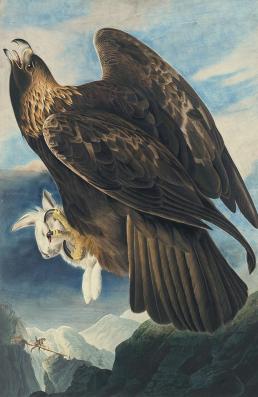A Missing Self-Portrait

Though the majority of Robert Havell’s prints recreate Audubon’s paintings in precise detail, notable changes appear in some cases. In his painting of the Golden Eagle, Audubon has included a self-portrait. In the middle distance, beyond his depiction of what he called the “king of birds,” the intrepid woodsman-naturalist crosses a chasm by way of a precarious, fallen-tree bridge; slung across his back, he carries a dead eagle. The image suggests the dangerous lengths to which Audubon might go to collect specimens for his work. While it is true that Audubon traveled far and wide across the American wilderness hunting for new bird species, records indicate that Audubon purchased a live adult eagle from a Boston merchant as the model for this painting. Nevertheless, Audubon labored over this painting, which took him some 60 hours to complete; correspondence from the period indicates that he worked so intensely that he became physically ill from the effort. It is not known why the human figure was left out of Havell’s print.
Audubobn’s Watercolor Printed Plate
Golden Eagle (Plate 181)
From Ornithological Biography, or, An Account of the Habits of the Birds of the United States of America, by John James Audubon, 1831–49.
The Golden Eagle, although a permanent resident in the United States, is of rare occurrence, it being seldom that one sees more than a pair or two in the course of a year. … Although possessed of a powerful flight it has not the speed of many Hawks, nor even of the White-headed Eagle. It cannot, like the latter, pursue and seize on the wing the prey it longs for, but is obliged to glide down through the air for a certain height to insure the success of its enterprise. The keenness of its eye, however, makes up for this defect, and enables it to spy, at a great distance, the objects on which it preys; and it seldom misses its aim, as it falls with the swiftness of a meteor towards the spot on which they are concealed. When at a great height in the air, its gyrations are uncommonly beautiful, being slow and of wide circuit, and becoming the majesty of the king of birds.
READ Audubon’s complete text at Audubon.org
Audubon’s Creative Process at Beinecke Library, Installation 1/3 – Read More

